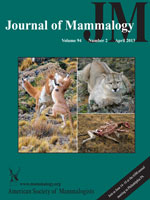The persistence of wildlife in fragmented landscapes is predicted to rely on the presence of critical habitat elements. In urban landscapes, the persistence of hollow-dependent bats arguably depends upon the protection of roosting habitat, yet knowledge of bat roosting requirements within these landscapes is limited. We used radiotelemetry to locate day roosts of a species considered sensitive to urbanization, Gould's long-eared bat (Nyctophilus gouldi), in suburban bushland in Sydney, New South Wales, Australia. We compared roost selection data collected for 9 individuals during the mating season (March–April 2009) and 10 individuals during the maternity season (November–December 2009). We found 41 roosts of N. gouldi under decorticating bark and in tree hollows, which were all located in 1 suburban bushland reserve (∼40 ha), with roosts rarely located elsewhere, despite the abundance of available trees in smaller patches outside of the reserve. N. gouldi displayed a clear preference for trees with a greater amount of understory and canopy cover, and only roosted where the extent of forest cover in the local landscape was greatest. Maternity roosts also were predominately located in gullies, and closer to creek lines than expected. Roost switching differed significantly between seasons, with lactating females switching roosts significantly more often than nonlactating females, where roost switching occurred after 1 day on 71% of occasions. Because competition with other fauna for hollows has been suggested as a potential threat, systematic observations of hollow-using bird species, including rainbow lorikeets (Trichoglossus haematodus), were conducted. We observed birds occupying bat roosts on days following bat occupancy, and bats roosted in trees where there were fewer hollow-using birds than randomly available trees. We recommend that further examination of hollow competition be undertaken because abundant, urban-adapted, hollow-nesting birds may render hollows a limiting resource to hollow-users such as bats in urban landscapes. Protection of a network of potential roost trees in suburban bushland remnants, particularly along creek lines, will assist in maintaining this critical resource for bats.
How to translate text using browser tools
1 April 2013
Roost selection in suburban bushland by the urban sensitive bat Nyctophilus gouldi
Caragh G. Threlfall,
Bradley Law,
Peter B. Banks
ACCESS THE FULL ARTICLE

Journal of Mammalogy
Vol. 94 • No. 2
April 2013
Vol. 94 • No. 2
April 2013
insectivorous bat
Nyctophilus gouldi
radiotracking
roost selection
tree hollows
urban ecology




